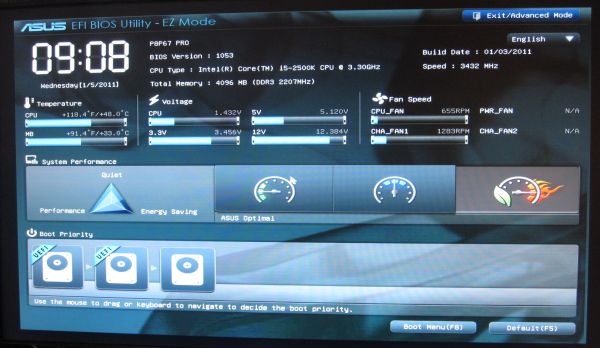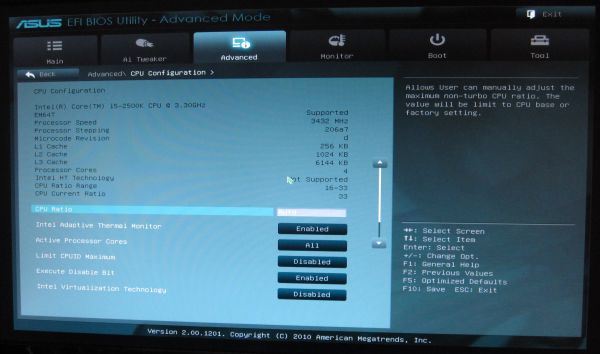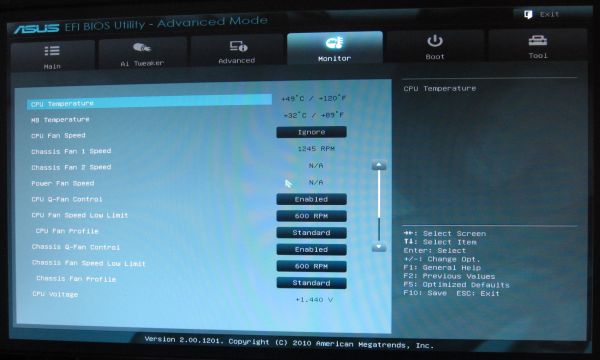The Battle of the P67 Boards - ASUS vs. Gigabyte at $190
by Ian Cutress on January 20, 2011 4:15 PM EST- Posted in
- Motherboards
- Gigabyte
- Asus
- P67
ASUS bring a lot of innovation to the UEFI table over what I have seen from other vendors. The implementation of EZ mode (‘easy’ mode, for us Brits that pronounce that letter ‘zed’) gives the screen below on first entering the UEFI. At a glance, it gives vital motherboard information – CPU, speed, memory, temperatures, voltages, fan speeds, and boot order. The boot order is a great addition, allowing the user to drag-click the order they want. Also available is the three performance options – low power, standard, and performance.
By clicking onto the advanced mode, we get a more BIOS-esque representation of all the motherboard features. The Ai tweaker provides all the overclocking tools we would expect, and more than you find in the Ai Suite in the OS. Features use either a text box for typing values, or a selection box for preset values. The user can utilise the mouse or the keyboard for either task.
Elements such as enhanced sleep states appear under the Advanced CPU Configuration menu, where cores and ratios can be determined. In the Onboard Devices section, if you are not using the Marvell SATA ports, it is advised that this be switched off, to increase boot time by 1-2 seconds.
Fan controls are found in the Monitor tab, where a low limit fan RPM can be given and fan control can be switched between standard/silent/turbo/manual. In manual mode, you can adjust the upper and lower temperature of the fan and at which percentage speed it should run at those temperatures.
Users can specify advanced mode to be shown as soon as the UEFI is selected, and ten UEFI profiles can be saved. The UEFI can also be updated through the Tools tab if the latest file is supplied on a USB drive and plugged in before the ‘update’ option is chosen.
Overclocking
Overclocking on the P8P67 Pro was easy. The UEFI EZ mode offers a performance mode option, which on selecting, enabled the XMP profile of the memory, applied a 103 BCLK, and set the turbo limit to 42x, giving a 4.33 GHz overclock.
As the Ai Suite offers the ‘Auto Tuning’ option, I selected this in the OS and let the program do its thing. After a couple of reboots, and a BSOD, the OS booted into a screen showing a 43x multiplier at 103.5 BCLK (4.45 GHz), and attempted a series of stability tests, slowing increasing the BCLK by 0.5 every 30 seconds. At 105.5 BCLK, a BSOD screen appeared and seemed to crash halfway through, requiring me to reset the system physically. On the next boot, it was stated that the 43x103.5 overclock was applied and now usable. This system is likeable as it promises to adjust depending on how overclockable the processor is.
The downside is that the Ai Suite is quite conservative. I kept with the 103.5 BCLK and went into the UEFI. In advanced mode, adjusting the turbo ratio by one each time and rebooting led to a 46x multiplier (4.76 GHz) successfully passing stability tests. For 47x multiplier (4.86 GHz), I increased the PLL to 1.9V, CPU VCore to 1.42 V, and adjusted the short/long power limits to 150 W/130 W to get a successful stability test pass. This automatically set the memory to a command rate of 3T, so was set back to 1T manually. The 48x multiplier did not boot at this level, and I was not prepared to up the VCore or power limits any more. A 4.86 GHz overclock is very respectable!
At 4.86 GHz (47% OC over 3.3 GHz/non turbo/multithreaded, 31% OC over 3.7 GHz/turbo/single-threaded), the 3D Movement benchmark was run. In single thread mode, a score of 148.92 was achieved, a 31% increase. In multi-threaded mode, a score of 477.60 was achieved, a 37% increase.




















137 Comments
View All Comments
Rick83 - Friday, January 21, 2011 - link
An ASUS Xonar DX costs around 50-70$ and does the same, and remains portable to any pcie board. I chose to go with that in the end...sweetspot - Friday, January 21, 2011 - link
See this is the point exactly overlooked,""go get so and so sound card to solve your problems, but now look at the equation posted in the review ""
2x 190 mobos or the 150 mobo which is better save 40 bucks ??
See how can you save 40 bucks when they clearly did not do sound review at all, so you now need to go pay the extra 50-70 bucks for add on sound card, now you are not saving 40 bucks with the Asrock board are ya.
Sure reader can go elsewhere and do alot of extra research on the parts for that info, but the review sites are supposed to cover that whcih is the whole reason people read them in the 1st place to get info they dont have access to read and not have to go web hopping for each detail to get information, and let an expert reviewer cover that research and testing for them, the whole reason review sites exsist. leaving out details so readers have to go elsewhere for items they reviewed is not a very helpfull at all, and readers waste time reading this to find out they are SOL later on, and need to spend more time on other sites for overlooked details.
Sound is not small item or bug oversite, every mobo computer usually sound is a key part of their use for home / entertainment use types. So skipping sound and other mojor compnents in a review is terrible to the reader.
Voldenuit - Friday, January 21, 2011 - link
Blegh. Too expensive.Pass.
Concillian - Friday, January 21, 2011 - link
Agree.Seen a fair number of reviews of various $150+ P67 boards.
OCing the 2500k looks to be about as non-complex as it gets, does a mobo really make a big difference anymore aside from 20 phase VRMs or whatever for the people doing water and phase change cooling and pumping 1.5 volts through these things?
Seems like a normal person on air going for 4.4-4.6 should need nothing fancy except whatever pci-E slot config and ports they are after.
I'm waiting on a <$150 roundup somewhere.
Rick83 - Friday, January 21, 2011 - link
The worst part, is that I got a p55 UD5 for 150 euro, which has more features than the new UD5. (And cost less at launch)I don't even want to talk about the feature-decay with regard to my IP35 Pro.
It's a sad state for the mobo buyer and best to stick to the low end.
Cashano - Friday, January 21, 2011 - link
I read a lot of comments about wait for the (X/Z)(67/68) boards, problem is by then AMD is on the playing field with they new chipset and boards, but lets look at todays boards.When testing boards at $190, i would say its more fitting to test the ASRock P67 Extreme6 instead of the ASRock P67 Extreme4, seeing that its closer to the $190 mark and alot more SATA and V16 power, but thats just what I think.
Cashano.
Cashano - Friday, January 21, 2011 - link
Forgot to add, that Ext6 has 2x 1Gbit LAN, or combined 2Gbit :P new feature.Cashano
seamusmc - Friday, January 21, 2011 - link
Who really uses that feature though. I've never met anyone that takes advantage of that. Would be neat to try it.Hogan773 - Friday, January 21, 2011 - link
No - the POINT is that you compare based on what you GET and the ASRock is delivering all the features (and more) vs the $190 tier at both ASUS and GB.Maybe you're different, but when I buy something, my thought process is not "OK how much to I want to spend" but rather "what features do I want to buy" and from there, where can I get the lowest dollar price on said features.
BTW beyond the bigger power phases there doesn't seem to be that many diffs between the ASR 4 and ASR 6. Thats prob because the ASR 4 is pretty fully loaded.
Cashano - Friday, January 21, 2011 - link
You are right that there isn't a lot of difference between X4 and 6, from what i can see it is,X6 has 2x SATA3(raid), 4x SATA3(raid), 4x SATA2(raid), and V16+2 phase power, and Dual Lan.
X4 has 2x SATA3(raid), 2x SATA3(raid), 4x SATA2(raid), and V8+2 phase power, and Single Lan.
I don't know the price difference is in the US, I think its down to about $10.
Well my thought process is, what do I need here and now for cheapest price, and what do I need in 3 to 6 months, for expansion and upgrades (like crossfire and hard disk's) but that's just me.
But yes I would take the X4 over X6 if i didn't use Dual lan, or used 2 Raid setups.
Cashano